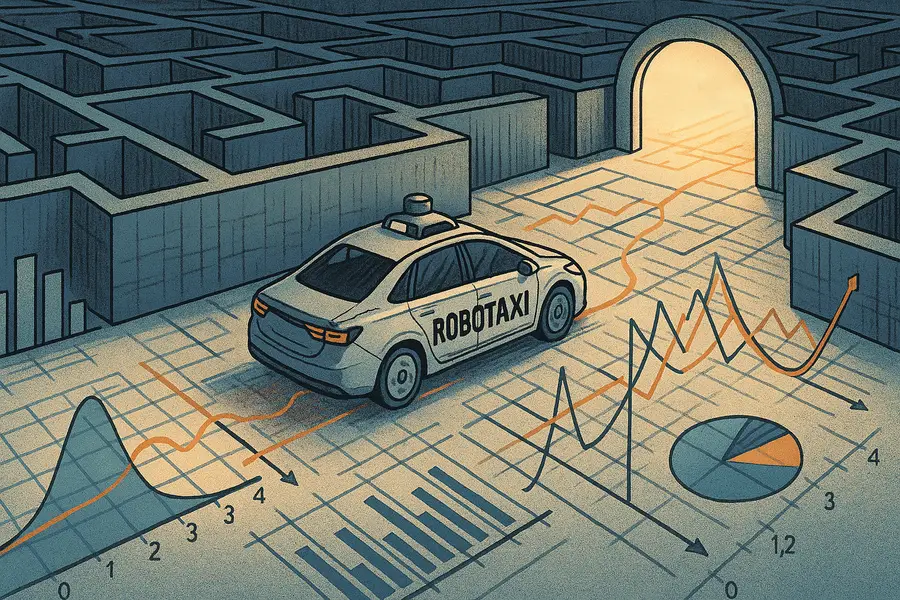Beyond the numbers: Decoding a robotaxi company’s earnings reports

Beyond the financial figures, real determinants of success lie in the details of an operator’s unmanned driving systems and the scale of their deployments
By Yang Zhe
Since their listings on the Nasdaq at the end of last year, the regular stream of quarterly earnings reports from Pony AI (PONY.US) and WeRide (WRD.US) have offered a new lens onto robotaxi operators and their broader sector.
First and foremost, robotaxi companies won’t be profitable anytime soon. Even leading players can only hope to turn positive in terms of their unit economics — a widely recognized industry consensus. That means traditional valuation tools such as P/E ratios are irrelevant. With annual revenues of only a few hundred million yuan, or tens of millions of dollars, P/S ratios are also not meaningful. The sector resembles both robotics and innovative drugs: what investors care about is the size of the future market and each company’s probability of success.
Just as humanoid robots won’t be taking care of your retirement in the near term, investing in robotics companies is about their understanding of AI, not how many robots they send to perform at China’s Lunar New Year Spring Festival Gala on TV. While the market potential for robotaxis is widely acknowledged, profitability is still a future proposition. What really matters is the probability of future earnings, not short-term sales of vehicles to clients for one-off revenue. If valuations were based on car sales, autonomous driving companies would have to be valued like traditional automakers. But for a company that sells only a few hundred or thousand cars per year, its fair value would be close to zero.
Therefore, for L4 companies making completely autonomous vehicles — whether robotaxis or robotrucks — earnings reports, along with regular news flow, should be used to assess long-term plans, not quarterly profits. After all, there are no profits yet, just revenue.
In this race, investors must ask two key questions: First, do you accept the scenarios each company has painted? Second, after the promises are made, can you actually track the company’s progress? Tracking matters. Otherwise, you risk being misled. In the robotaxi sector, assume everyone is exaggerating, and focus on verifiable metrics that can’t be dressed up.
The real benchmark
So, how do you verify progress in robotaxi companies? Two metrics stand out: unmanned operation and scalability, in that order. A company must first demonstrate true unmanned capability, then expand the fleet at scale under unmanned conditions.
Fleet scale should not be measured simply by the number of cars owned as assets, but rather by how easily users in different locations can hail an unmanned vehicle, and whether these cars can operate under extreme scenarios, during rush hours and in adverse weather. The more driverless vehicles on the road and the greater the daily unmanned mileage, the higher the safety risks. Each company knows the internal accident probability per average kilometers without a safety driver, though such data is hard for outsiders to obtain. Instead, it manifests in observable variables: whether cars can operate without safety drivers, whether they can accept trips during rush hours and in crowded districts, and how many unmanned cars are actively available for on-demand rides each day.
Companies lacking confidence in their technical capabilities or safety records will try to limit operations in complex scenarios, and restrict operating hours or road segments to minimize risk exposure.
Thus, while robotaxis may appear similar on the surface, there’s a huge gap between a fleet where you can only hail cars with safety drivers, whether in the front or passenger seat, and one where you can hail 10 or even 100 driverless cars in public service. Each jump represents an order-of-magnitude increase in risk exposure, and an order-of-magnitude higher bar for technology and safety. Likewise, companies that allow rides during peak hours and in busy districts are fundamentally different from those that only operate in quiet times and locations. Accident rates in complex scenarios are significantly higher, even for human drivers.
Once safety indicators and technical requirements diverge by an order of magnitude, the technology gap is real. Lagging companies may never cross into the next tier. As L4 robotaxis emerge as the first large-scale commercial embodiment of intelligent AI agents, the bar for R&D is exceptionally high — and not every team can deliver.
Autonomous driving is, at its core, a game of probabilities. Without statistical rigor, neither autonomous driving nor investment in the sector is possible. Through earnings reports, public filings, and the user experience visible to the public, investors can infer the technical gaps between companies. And when gaps exist, so too do differences in each company’s probability of ultimately reaching the robotaxi “endgame.”
Yang Zhe is a senior director at Pony AI with nearly 10 years of experience in the autonomous driving industry. You can reach him at: mail@yangzhe1991.org
This commentary is the view of the writer and does not necessarily reflect the views of Bamboo Works
To subscribe to Bamboo Works weekly free newsletter, click here






